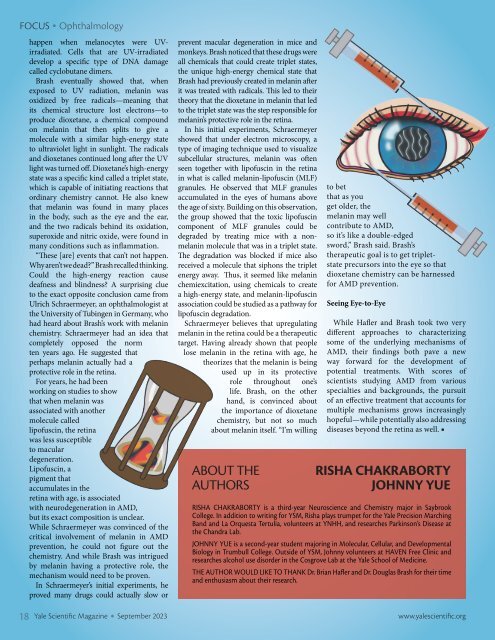YSM Issue 96.3
Create successful ePaper yourself
Turn your PDF publications into a flip-book with our unique Google optimized e-Paper software.
FOCUS<br />
Ophthalmology<br />
happen when melanocytes were UVirradiated.<br />
Cells that are UV-irradiated<br />
develop a specific type of DNA damage<br />
called cyclobutane dimers.<br />
Brash eventually showed that, when<br />
exposed to UV radiation, melanin was<br />
oxidized by free radicals—meaning that<br />
its chemical structure lost electrons—to<br />
produce dioxetane, a chemical compound<br />
on melanin that then splits to give a<br />
molecule with a similar high-energy state<br />
to ultraviolet light in sunlight. The radicals<br />
and dioxetanes continued long after the UV<br />
light was turned off. Dioxetane’s high-energy<br />
state was a specific kind called a triplet state,<br />
which is capable of initiating reactions that<br />
ordinary chemistry cannot. He also knew<br />
that melanin was found in many places<br />
in the body, such as the eye and the ear,<br />
and the two radicals behind its oxidation,<br />
superoxide and nitric oxide, were found in<br />
many conditions such as inflammation.<br />
“These [are] events that can’t not happen.<br />
Why aren’t we dead?” Brash recalled thinking.<br />
Could the high-energy reaction cause<br />
deafness and blindness? A surprising clue<br />
to the exact opposite conclusion came from<br />
Ulrich Schraermeyer, an ophthalmologist at<br />
the University of Tubingen in Germany, who<br />
had heard about Brash’s work with melanin<br />
chemistry. Schraermeyer had an idea that<br />
completely opposed the norm<br />
ten years ago. He suggested that<br />
perhaps melanin actually had a<br />
protective role in the retina.<br />
For years, he had been<br />
working on studies to show<br />
that when melanin was<br />
associated with another<br />
molecule called<br />
lipofuscin, the retina<br />
was less susceptible<br />
to macular<br />
degeneration.<br />
Lipofuscin, a<br />
pigment that<br />
accumulates in the<br />
retina with age, is associated<br />
with neurodegeneration in AMD,<br />
but its exact composition is unclear.<br />
While Schraermeyer was convinced of the<br />
critical involvement of melanin in AMD<br />
prevention, he could not figure out the<br />
chemistry. And while Brash was intrigued<br />
by melanin having a protective role, the<br />
mechanism would need to be proven.<br />
In Schraermeyer’s initial experiments, he<br />
proved many drugs could actually slow or<br />
prevent macular degeneration in mice and<br />
monkeys. Brash noticed that these drugs were<br />
all chemicals that could create triplet states,<br />
the unique high-energy chemical state that<br />
Brash had previously created in melanin after<br />
it was treated with radicals. This led to their<br />
theory that the dioxetane in melanin that led<br />
to the triplet state was the step responsible for<br />
melanin’s protective role in the retina.<br />
In his initial experiments, Schraermeyer<br />
showed that under electron microscopy, a<br />
type of imaging technique used to visualize<br />
subcellular structures, melanin was often<br />
seen together with lipofuscin in the retina<br />
in what is called melanin-lipofuscin (MLF)<br />
granules. He observed that MLF granules<br />
accumulated in the eyes of humans above<br />
the age of sixty. Building on this observation,<br />
the group showed that the toxic lipofuscin<br />
component of MLF granules could be<br />
degraded by treating mice with a nonmelanin<br />
molecule that was in a triplet state.<br />
The degradation was blocked if mice also<br />
received a molecule that siphons the triplet<br />
energy away. Thus, it seemed like melanin<br />
chemiexcitation, using chemicals to create<br />
a high-energy state, and melanin-lipofuscin<br />
association could be studied as a pathway for<br />
lipofuscin degradation.<br />
Schraermeyer believes that upregulating<br />
melanin in the retina could be a therapeutic<br />
target. Having already shown that people<br />
lose melanin in the retina with age, he<br />
theorizes that the melanin is being<br />
used up in its protective<br />
role throughout one’s<br />
life. Brash, on the other<br />
hand, is convinced about<br />
the importance of dioxetane<br />
chemistry, but not so much<br />
about melanin itself. “I’m willing<br />
ABOUT THE<br />
AUTHORS<br />
to bet<br />
that as you<br />
get older, the<br />
melanin may well<br />
contribute to AMD,<br />
so it’s like a double-edged<br />
sword,” Brash said. Brash’s<br />
therapeutic goal is to get tripletstate<br />
precursors into the eye so that<br />
dioxetane chemistry can be harnessed<br />
for AMD prevention.<br />
Seeing Eye-to-Eye<br />
While Hafler and Brash took two very<br />
different approaches to characterizing<br />
some of the underlying mechanisms of<br />
AMD, their findings both pave a new<br />
way forward for the development of<br />
potential treatments. With scores of<br />
scientists studying AMD from various<br />
specialties and backgrounds, the pursuit<br />
of an effective treatment that accounts for<br />
multiple mechanisms grows increasingly<br />
hopeful—while potentially also addressing<br />
diseases beyond the retina as well. ■<br />
RISHA CHAKRABORTY<br />
JOHNNY YUE<br />
RISHA CHAKRABORTY is a third-year Neuroscience and Chemistry major in Saybrook<br />
College. In addition to writing for <strong>YSM</strong>, Risha plays trumpet for the Yale Precision Marching<br />
Band and La Orquesta Tertulia, volunteers at YNHH, and researches Parkinson’s Disease at<br />
the Chandra Lab.<br />
JOHNNY YUE is a second-year student majoring in Molecular, Cellular, and Developmental<br />
Biology in Trumbull College. Outside of <strong>YSM</strong>, Johnny volunteers at HAVEN Free Clinic and<br />
researches alcohol use disorder in the Cosgrove Lab at the Yale School of Medicine.<br />
THE AUTHOR WOULD LIKE TO THANK Dr. Brian Hafler and Dr. Douglas Brash for their time<br />
and enthusiasm about their research.<br />
18 Yale Scientific Magazine September 2023 www.yalescientific.org

















